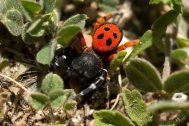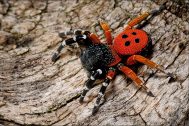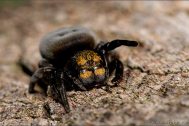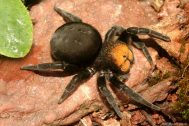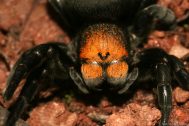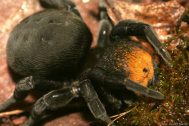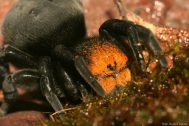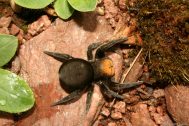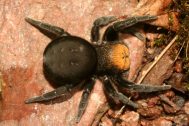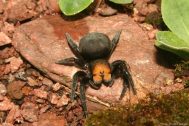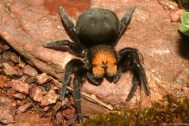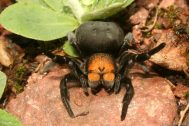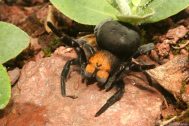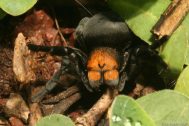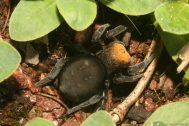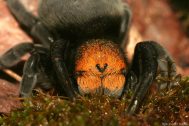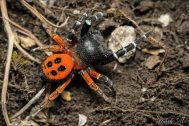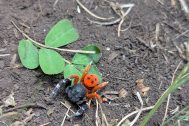| Nálezy podle období | |||||
|---|---|---|---|---|---|
| Eresidae | 0-1900 | 1901-1950 | 1951-2000 | 2001+ | ∑ |
| Eresus moravicus Řezáč, 2008 Kriticky ohrožený | 13× | 23× | 36× | ||
Eresus moravicus Řezáč, 2008
| České jméno | stepník moravský |
|---|---|
| Stupeň ohrožení | Kriticky ohrožený |
| Nálezy | 36 nálezů, 8 kvadrátů |
| První nález |
1941, F. Miller, Řezáč et al. 2008 |
| Poslední nález | 2025 |
| Areál rozšíření | European - Pan. [Pan.] |
| Fytogeografická oblast |
|
| Původnost stanovišť |
|
| Vlhkost stanovišť |
|
| Stratum |
|
| Osvětlení stanovišť |
|
| Hojnost výskytu |
|
| Nadm. výška | 200-550 |
Literatura
Výsledky faunistického průzkumu pavouků a sekáčů na vybraných lokalitách na území NP Podyjí v roce 2019
A total of 114 spider species from 25 families and one harvestmen species were found during the zoological research at several sites in the Podyjí National Park during 2019. Of them, forty-one species are listed in the Red List of spiders of the Czech Republic. Four new species for the Podyjí NP were recorded – Callilepis nocturna (Linnaeus, 1758), Euryopis laeta (Westring, 1861), Phrurolithus minimus C. L. Koch, 1839 and Trichoncus auritus (L. Koch, 1869). Among the most interesting species, four critically endangered spiders – Civizelotes caucasius (L. Koch, 1866), Phrurolithus szilyi Herman, 1879, Gnaphosa modestior Kulczyński, 1897 and Eresus moravicus Řezáč, 2008 should be mentioned. Other rare species include Acartauchenius scurrilis (O. Pickard-Cambridge, 1873), Agyneta fuscipalpa (C. L. Koch, 1836), Arctosa figurata (Simon, 1876), Atypus affinis Eichwald, 1830, Bassaniodes robustus (Hahn, 1832), Callilepis schuszteri (Herman, 1879), Centromerus incilium (L. Koch, 1881), Centromerus leruthi Fage, 1933, Cheiracanthium effossum Herman, 1879, Drassyllus villicus (Thorell, 1875), Euryopis quinqueguttata Thorell, 1875, Frontinellina frutetorum (C. L. Koch, 1835), Gibbaranea gibbosa (Walckenaer, 1802), Gnaphosa opaca Herman, 1879, Haplodrassus cognatus (Westring, 1861), Haplodrassus dalmatensis (L. Koch, 1866), Haplodrassus minor (O. Pickard-Cambridge, 1879), Heterotheridion nigrovariegatum (Simon, 1873), Kishidaia conspicua (L. Koch, 1866), Leptorchestes berolinensis (C. L. Koch, 1846), Minicia marginella (Wider, 1834), Phrurolithus pullatus Kulczyński, 1897, Trichopterna cito (O. Pickard-Cambridge, 1873), Walckenaeria simplex Chyzer, 1894, Zelotes erebeus (Thorell, 1871) and Zora manicata Simon, 1878.Výsledky faunistického průzkumu pavouků a sekáčů na vybraných lokalitách na území NP Podyjí v roce 2019
A total of 114 spider species from 25 families and one harvestmen species were found during the zoological research at several sites in the Podyjí National Park during 2019. Of them, forty-one species are listed in the Red List of spiders of the Czech Republic. Four new species for the Podyjí NP were recorded – Callilepis nocturna (Linnaeus, 1758), Euryopis laeta (Westring, 1861), Phrurolithus minimus C. L. Koch, 1839 and Trichoncus auritus (L. Koch, 1869). Among the most interesting species, four critically endangered spiders – Civizelotes caucasius (L. Koch, 1866), Phrurolithus szilyi Herman, 1879, Gnaphosa modestior Kulczyński, 1897 and Eresus moravicus Řezáč, 2008 should be mentioned. Other rare species include Acartauchenius scurrilis (O. Pickard-Cambridge, 1873), Agyneta fuscipalpa (C. L. Koch, 1836), Arctosa figurata (Simon, 1876), Atypus affinis Eichwald, 1830, Bassaniodes robustus (Hahn, 1832), Callilepis schuszteri (Herman, 1879), Centromerus incilium (L. Koch, 1881), Centromerus leruthi Fage, 1933, Cheiracanthium effossum Herman, 1879, Drassyllus villicus (Thorell, 1875), Euryopis quinqueguttata Thorell, 1875, Frontinellina frutetorum (C. L. Koch, 1835), Gibbaranea gibbosa (Walckenaer, 1802), Gnaphosa opaca Herman, 1879, Haplodrassus cognatus (Westring, 1861), Haplodrassus dalmatensis (L. Koch, 1866), Haplodrassus minor (O. Pickard-Cambridge, 1879), Heterotheridion nigrovariegatum (Simon, 1873), Kishidaia conspicua (L. Koch, 1866), Leptorchestes berolinensis (C. L. Koch, 1846), Minicia marginella (Wider, 1834), Phrurolithus pullatus Kulczyński, 1897, Trichopterna cito (O. Pickard-Cambridge, 1873), Walckenaeria simplex Chyzer, 1894, Zelotes erebeus (Thorell, 1871) and Zora manicata Simon, 1878.Habitat selection by threatened burrowing spiders (Araneae: Atypidae, Eresidae) of central Europe: evidence base for conservation management.
Habitat selection in sedentary, long-lived burrowing spiders is a key life-history event that directly affects their reproductive success. In this study, we analyzed the role of the chemical and physical properties of soil in habitat selection by threatened temperate burrowing spiders. We examined 296 burrows of three Atypus spp. and three Eresus spp. at 68 sites in Czechia. We found that the study species were associated with soils that have high or very high cation exchange capacity, which allows the presence of a stable nd humid microclimate in their burrows. We found that specific bedrock types can be used as predictors of the presence of particular study species. All Eresus spp. avoided compacted soils. However, when present in soils with very low penetration resistance, they were limited to sites with high soil cohesion. The burrows of all study species were located at well-drained sites. The study species seemed to be selective for a steppe-like character of their microhabitat but not necessarily for its southward orientation. We found the study species even at sites where steppes were present in the early 1950s and that underwent later afforestation but not extensive landscaping or plowing. What types of disturbances can be sustained by the study species and how long it takes the decreased populations to recover after, e.g., trampling associated with grazing, remain to be investigated.
Taxonomic review and phylogenetic analysis of central European Eresus species (Araneae: Eresidae)
Ladybird spiders (Eresus spp.) have attracted scientific interest since the 18th century, but taxonomical knowledge of the genus is unsatisfactory. Early classification based on colour and size variation divided European Eresus into numerous species. These were later lumped into one predominant morphospecies, Eresus niger/E. cinnaberinus, which could be found from Portugal to Central Asia. Here, we perform a major revision of Eresus from northern and central Europe using morphological, phenological, habitat, distribution and molecular data. Three species, Eresus kollari, Eresus sandaliatus and Eresus moravicus sp. n. were distinguished. The name E. niger (originally Aranea nigra) cannot be used as the name A. nigra was used for a previous spider species. The name E. cinnaberinus is considered a nomen dubium. The three species differ in size, colour pattern, shape of prosoma and copulatory organs, phenology, and have slightly different habitat requirements. No morphologically intermediate forms were recorded. In contrast to distinct morphology and phenology, the genus is genetically complex. Genetically, the mitochondrial haplotypes of Eresus sandaliatus and Eresus moravicus sp. n. are monophyletic, whereas those of Eresus kollari are paraphyletic. Eastern central European Eresus kollari is likely a hybrid lineage between Eresus sandaliatus and the monophyletic western central European Eresus kollari. Because eastern and western European Eresus kollari are morphologically and phenologically indistinguishable, we did not formally split them. However, detailed population-based research in the future may partition Eresus kollari into additional species.
Fotografie
Statistiky
Dle měsíce v roce
Dle nadmořské výšky
Dle metody sběru (36 použitých nálezů)
| Eresus moravicus Řezáč, 2008 CR | Samci | Samice | Mláďata | Nálezy |
|---|---|---|---|---|
| Pozorování | 7 | 1 | 0 | 4 |
| Zemní past | 73 | 3 | 14 | 17 |
| Neurčeno | 15 | 2 | 0 | 7 |
| Individuální sběr | 5 | 1 | 0 | 6 |
| Fotografie | 11 | 1 | 0 | 2 |
| Samci | Samice | Mláďata | Nálezy |
Dle biotopu (35 použitých nálezů)
| Eresus moravicus Řezáč, 2008 CR | Samci | Samice | Mláďata | Nálezy |
|---|---|---|---|---|
| Neurčeno | 35 | 2 | 8 | 18 |
| Zahrady | 0 | 1 | 0 | 1 |
| Skalní stepi na vápenci | 53 | 2 | 6 | 9 |
| Lesostepní doubravy | 5 | 2 | 0 | 3 |
| Ruderály | 1 | 0 | 0 | 1 |
| Travnaté stepi | 11 | 1 | 0 | 2 |
| Písčiny | 1 | 0 | 0 | 1 |
| Samci | Samice | Mláďata | Nálezy |





